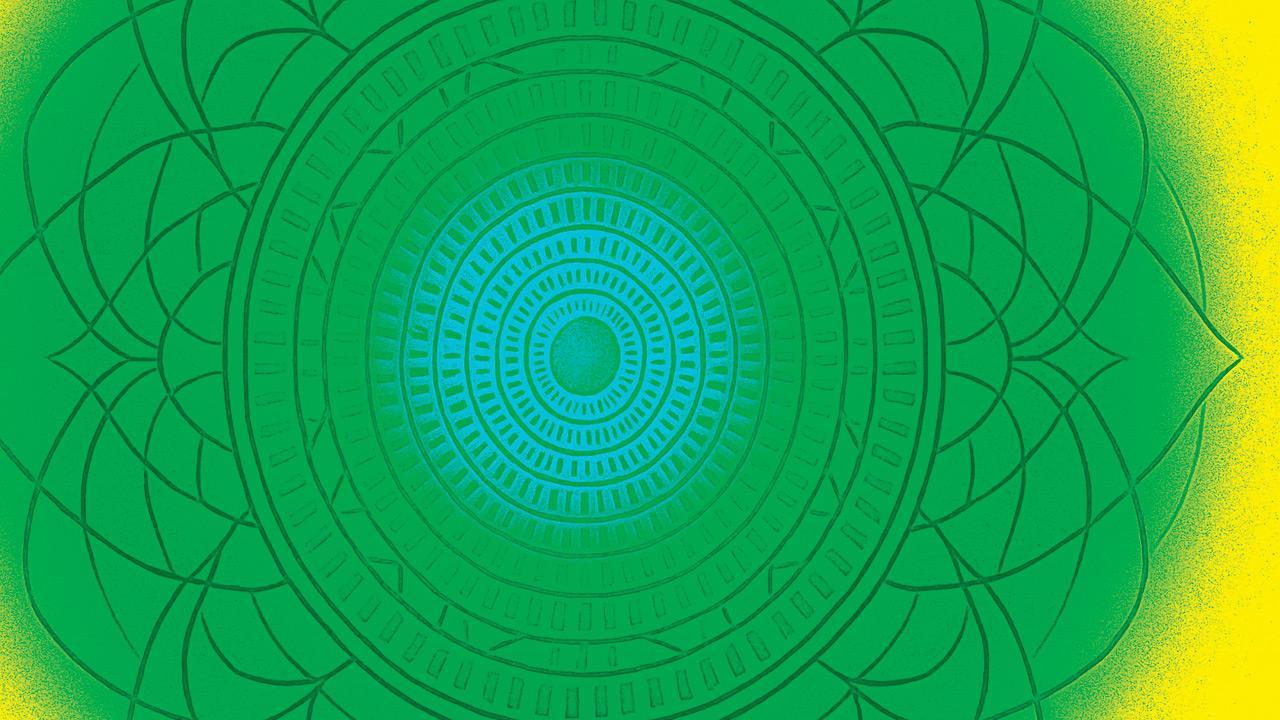I don’t want no banana fritters, I don’t want no bananas, I don’t want no banana leaf, all I want is some of that ol’ Musa Pseudostem Khich Khach

A design based on a banana stem’s cross-section. Illustration by C Y Gopinath using AI
 Take a medium-sized Musa Pseudostem. Chop it finely and boil till tender. Spice it and eat while costive.
Take a medium-sized Musa Pseudostem. Chop it finely and boil till tender. Spice it and eat while costive.
There, that’s how you do it. I’ve given the recipe away. The Musa Pseudostem is the tender inner core, or pith, of the banana tree’s stem. You can now amaze your friends by cooking up a Banana Tree Khich Khach.
They’ll nudge each other, of course, and whisper into their respective ears, “Goodness, he or she doesn’t know which part of the tree is edible. Next thing, he or she will be serving us Teakwood Quiche.”
Don’t be daunted by the mockery, because God is on your side. He will make them all costive and that will be the end of them. When I was little, my mother took me aside one day in my grandfather’s sprawling rubber estate in Kerala and said, “See these trees, son. Some are rubber, but many are banana trees. Every growing boy needs to eat a banana tree now and then. It is excellent for the bowels. The rough fibres of the banana stem act like a powerful broom, cleaning out the folds and crevices of your plicae circulares.”
That was how I first tasted Banana Tree Khich Khach, for want of a better name.
I fell in love with it and wanted to eat it every day. “Mother, mother,” I said to her. “This stuff is so good for my bowels that I want more and more of it. I don’t want no banana fritters, I don’t want no bananas, I don’t want no banana leaf, all I want is some of that ol’ Banana Tree Khich Khach.”

Let’s talk about Bombai Click the QR code above to join my WhatsApp group to share your Bombai stories for my book—and perhaps answer some of my Bombai questions
“Once a month is all you get,” she said sternly. “No one should eat it more than once a month, and less than once a month is asking for trouble. Besides, it is a nuisance to cook, and moreover, I don’t love it that much. Overbesides, your bowels aren’t that bad.”
You can get banana pseudostems in Matunga in Bombay. They look like pale white plastic plumbing pipes, shiny and smooth outside, and usually cut into one-foot segments. In those pre-Internet days, I dialled my mother, who was in Chicago with her daughter that particular day, and asked her exactly how much I should buy. She’s terrible with quantities, like all mothers, and she thought for a minute, while the dollars ticked by. Then she said, “About one-and-a-half Ponds talcum powder tins, to feed about five.” How perfect—a banana pseudostem does resemble a cylindrical talcum tin.
Buy the banana pseudostem carefully. Check for discolourations—there should be none—and ensure that it is tender and white. Cutting it is an art best mastered through practice. Oil your hands, because the pseudostem exudes a sticky pseudo-goo that is immune to soap. Peel away about two thick layers of the outer skin, about a centimetre or two deep, to expose the tender white pith within. This is the part you will
cook and eat.
Slice into discs about four millimetres thick and plop into water to which you’ve added half a cup of sour buttermilk to prevent discolouration. Pay attention to the lengths of ‘string’ that unwind as you cut. They should be assiduously removed and discarded.
Here’s how you make the Khich Khach.
Ingredients
1.5 banana pseudostems, prepared as described and cut into discs
1 cup tuvar dal
A little ural dal
A pinch of turmeric
A pinch of salt
1 tablespoon rice
3 or 4 red chillies
1/2 coconut, grated
1/2 teaspoon mustard seeds
1/2 tablespoon jeera
Some curry leaves
1. Finely chop the banana pseudostem discs.
2. Pressure cook the chopped banana pseudostem, together with one cup tuvar dal and some turmeric, with salt to taste. Maybe five whistles of a pressure cooker.
3. Meanwhile, take a tablespoon of rice, three red chillies, and fry in oil till just before the rice begins to redden. Grind to a paste with the grated coconut and the jeera.
4. Combine this paste with the pressure-cooked banana pseudostem and tuvar dal, adding some water if the result feels too thick. Let the Khich Khach come to a boil over a slow fire. The banana pseudostem absorbs the various subtleties in the coconut paste and emerges dressed to party.
5. Throw a half teaspoon of mustard seeds into hot oil or ghee. When it begins to pop, add a half teaspoon of urad dal. As the dal begins to turn a lovely golden colour, add a few whole red chillies, just for a few moments, and then throw the whole thing over the Khich Khach as a garnish.
It is now time to answer the question that has been distracting you. What, you are wondering, is the meaning of the word ‘costive’, mentioned so casually in the first paragraph? No, it is not another word for the price index, but simply means—oh, I couldn’t possibly. Go look it up, everyone has Google these days.
If you’re too busy or lazy for that, just make the Khich Khach and give your family a treat.
You can reach C Y Gopinath at cygopi@gmail.com
Send your feedback to mailbag@mid-day.com
The views expressed in this column are the individual’s and don’t represent those of the paper.
 Subscribe today by clicking the link and stay updated with the latest news!" Click here!
Subscribe today by clicking the link and stay updated with the latest news!" Click here!








